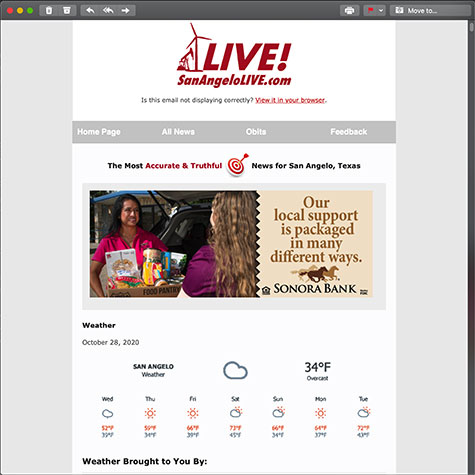By Jaden Edison, The Texas Tribune
Gov. Greg Abbott on Wednesday signed into law a bill providing roughly $8.5 billion in new funding for Texas public schools, offering relief to districts for teacher and support staff pay, operational expenses, special education, educator preparation, early childhood learning and campus safety.
The new dollars in House Bill 2, which lawmakers have dubbed “historic” because it marks the largest one-time public education investment in recent memory, will arrive after years of stagnant funding. That includes 2023, when the state gave schools targeted money in areas like school security but left billions more on the table due to the political fallout over private school vouchers.
Abbott signed a $1 billion voucher program into law last month. The Legislature granted final approval to the 231-page public school funding proposal in the last days of the 2025 legislative session, which concluded on Monday.
“It’s time that we Texans collectively recast our gaze to Texas being ranked number one for educating the children of the great state of Texas,” Abbott said Wednesday during a bill signing ceremony at Salado Middle School, a campus located north of Austin where he was surrounded by cheerful students, educators and lawmakers.
“House Bill 2 takes substantial steps towards achieving that goal,” the governor added. Abbott also told reporters he had no regrets about two years ago — when he vowed to not approve a major school funding bill if lawmakers did not pass vouchers — saying this year’s voucher and funding laws are “far superior” than the measures previously on the table.
HB 2 will largely go into effect on Sept. 1. Certain parts of the law will take effect next year.
School officials and public education advocates have praised the new funding while warning that the new dollars are a long way from catching districts up with inflation, which has ballooned their costs since the COVID-19 pandemic. HB 2, they say, also will not cure every hardship staring public education in the face, including multimillion-dollar budget deficits and school closures.
While the legislation does not give schools as much spending flexibility as they had hoped for, it makes targeted investments in areas lawmakers believe will leave the Texas’ public education system better off.
Here’s a breakdown of some key provisions.
Lawmakers devote new money to raise pay for teachers and support staff
Teachers will receive long-term pay raises based on their years of experience and the size of their school district, using the following criteria:
- Educators with three to four years of experience in districts with 5,000 or fewer students will get a $4,000 raise, while those with five or more years of teaching on their resume will earn $8,000.
- For districts with more than 5,000 students, teachers with three to four years of experience will earn a $2,500 raise, while those with five or more years of experience will receive $5,000.
First- and second-year teachers are not eligible for raises under the new system, known as the Teacher Retention Allotment. The raises for more experienced teachers are permanent, not one-time bonuses.
The new law also gives districts $45 per student that they can only use to increase the salaries of school counselors, librarians, nurses and other non-administrative support staff, as well as the teachers who do not qualify for raises under the new retention allotment.
Texas’ performance pay system for educators grows
Lawmakers expanded Texas’ Teacher Incentive Allotment, a state program that awards raises over a five-year period to classroom instructors who demonstrate that they have improved their students’ academic performance. HB 2 will allow more teachers in a district to qualify for raises, which will range from as low as $3,000 annually to as high as $36,000. Higher dollar amounts will go to the program’s highest performing teachers working in rural or high-poverty communities.
School districts can also decide to open up the incentive pay system to include principals and assistant principals. But doing so would mean the district can only offer salary increases to classroom teachers based on performance — not across the board — except for when adjusting for inflation.
Educators who have obtained their national teaching certification will continue to automatically qualify for raises through the Teacher Incentive Allotment under the new law, though the State Board for Educator Certification can now revoke their participation if it concludes that the requirements for the national designation do not comply with state law. The board will conduct an initial review of the national certifications no later than Dec. 31, 2026.
Schools will receive restricted funds for operational expenses
School districts will not see a significant increase to their base funding per student, known as the basic allotment, which grants them flexibility to tackle their campuses’ particular needs, from building maintenance to fine arts programs. That pot of money will only go up by $55 per student.
Instead, districts will get more targeted funding — $106 per student — to pay the costs of transportation, insurance, utilities, employee benefits and hiring retired educators, which has become more common as schools struggle to fill teacher vacancies.
Special education funding shifts to a more equitable approach
Texas is moving away from the long-scrutinized special education funding system that gives money to districts based on the classroom setting where a child with a disability receives instruction. Now, schools will receive dollars based on the individual needs of that student — an approach educators, lawmakers and public education advocates consider more equitable.
The new system, which Texas Education Commissioner Mike Morath will design, will take effect at the beginning of the 2026-27 school year. The education chief must consider the nature of services provided to students, the technology and equipment required and the professional needs of educators.
When HB 2 takes effect later this year, districts will also start receiving $1,000 for each assessment they conduct evaluating kids for disabilities.
Uncertified educators won’t be allowed to teach core subjects
School districts must finalize plans to ensure that no educators without formal classroom training teach children in reading, math, science and social studies — and they have until the 2029-30 school year to transition the uncertified teachers out of those classrooms. The Texas education commissioner may allow districts to delay implementation of the new requirement until Sept. 1, 2030.
None of the certification rules will apply to charter schools, which receive public funds but are privately managed.
To incentivize untrained teachers hired in the last three years to earn their certification, the state will provide a one-time payment of $1,000 to educators who get formal training by the end of 2026-27 school year.
The law also provides a salary of $10,000 to aspiring educators who participate in teacher residencies — training programs that provide them direct classroom experience under the guidance of seasoned instructors — while those who go through a traditional university or alternative certification route will get $3,000. For districts to qualify for the funding, their programs must meet several state requirements, including ensuring candidates spend time in a classroom for at least a full academic year.
Texas takes steps to help its youngest students with reading and math
The education commissioner will establish a list of brief assessments, known as screeners, that districts will use throughout the school year to evaluate foundational reading and math skills among students in kindergarten through third grade.
Superintendents are required to publicly report the results at a school board meeting and make them available to parents, who also have the option to opt their kids out of taking the assessments.
Lawmakers hope the screeners will help schools provide targeted support before it becomes too difficult for children to catch up. Students who are falling behind will receive additional tutoring.
The Legislature makes tweaks to help districts fund full-day pre-K
HB 2 also tries to help districts close Texas’ prekindergarten funding gap. The state currently requires that districts provide full-day pre-K to eligible children for free, but it only funds those services at a half-day level. Though the way pre-K is funded remains the same, the new law makes changes to the state’s funding system for early learning that could help some schools pay for the other half day.
Meanwhile, the bill expands free pre-K eligibility to include the children of teachers.
Schools receive more money to fulfill campus safety requirements
Additional funding will go toward helping districts fulfill safety mandates enacted by the Legislature after the Uvalde mass school shooting in 2022, a list that included hiring one armed security officer at each campus.
Districts will receive $20 per student and $33,540 for each campus, up from the current allocation of $10 per student and $15,000 per campus.
This article originally appeared in The Texas Tribune at https://www.texastribune.org/2025/06/04/texas-public-education-schools-funding-bill-explained/.
Subscribe to the LIVE! Daily
Required






Post a comment to this article here: